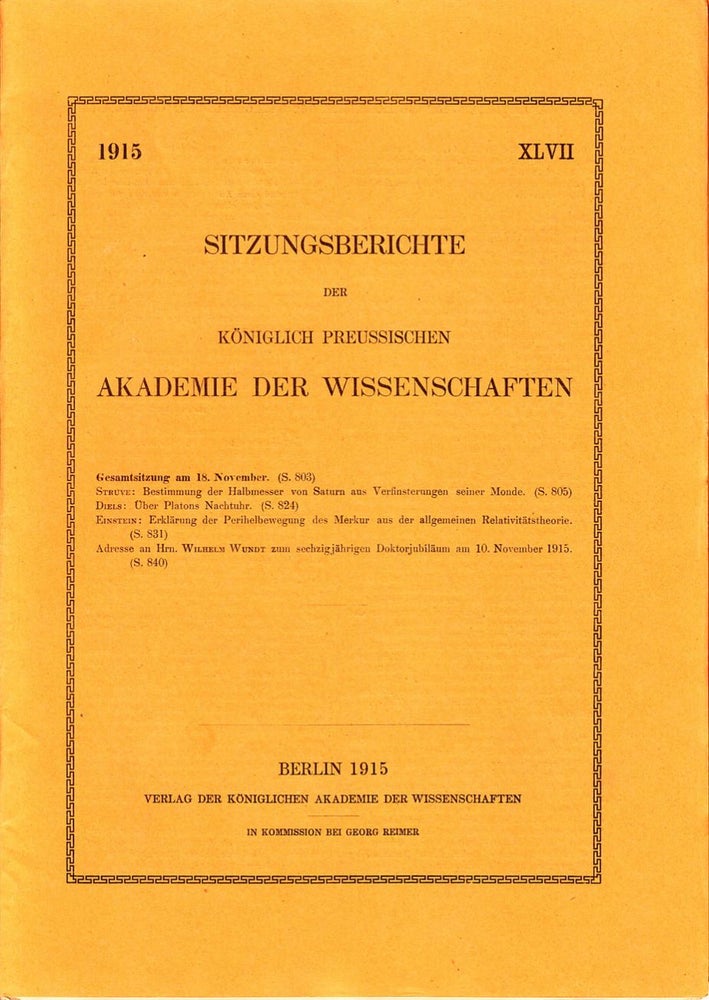Erklärung der Perihelbewegung des Merkur aus der allgemeinen Relativitätstheorie
“Einstein was in the throes of one of the most concentrated frenzies of scientific creativity in history. He was working, he said, ‘horrendously intensely’”. –Isaacson, referring to Einstein’s work on his November 1915 papers.
“During the past month I had one of the most exciting and strenuous times of my life, but also one of the most successful ones.” –Einstein, in a letter to Sommerfeld, on November 28, 1915.
FIRST PRINTING IN ORIGINAL WRAPPERS of one of Einstein's most important papers: his landmark work of November 18, 1915, containing the development and confirmation of crucial elements of his general theory of relativity.
By autumn 1915, Einstein experienced a “crisis” in his work on his gravitational equations and the general theory of relativity, forcing him to abandon several key elements of his earlier work. In October 1915, “Einstein shifted his focus from the physical strategy, which emphasized his feel for the basic principles of physics, and returned to a greater reliance on a mathematical strategy, which made use of the Riemann and Ricci tensors... ‘Einstein’s reversal,’ writes John Norton, ‘parted the waters and led him from bondage into the promised land of general relativity’... The result was an exhausting, four-week frenzy during which Einstein wrestled with a succession of tensors, equations, corrections, and updates that he rushed to the Prussian Academy in a flurry of four Thursday lectures” (Isaacson).
In Einstein's paper of November 18th (the third paper in the four-part weekly lecture series), he "presents two of his greatest discoveries. Each of these changed his life. The first result was that his theory ‘explains... quantitatively... the secular rotation of the orbit of Mercury, discovered by Le Verrier,... without the need of any special hypothesis.’ This discovery was, I believe, by far the strongest emotional experience in Einstein’s scientific life, perhaps in all his life. Nature had spoken to him. He had been right. ‘For a few days, I was beside myself with joyous excitement’. Later, he told Fokker that his discovery had given him palpitations of the heart. What he told de Haas is even more profoundly significant: when he saw that his calculations agreed with the unexplained astronomical observations, he had the feeling that something actually snapped in him...” (Pais).
The second discovery in Einstein’s November 18th paper was that “the bending of light is twice as large as he had found earlier.” This correct value would make Einstein an international celebrity when it was found to be accurate after the measurements taken during the May 1919 eclipse.
The discoveries in his November 18th paper formed an essential part of the more formal, complete presentation of the general theory that appeared in his 1916 paper in Annalen der Physik. See: Isaacson, Einstein, pp. 211-221 and Pais, Subtle is the Lord pp.250-261.
IN: Sitzungsberichte der Königlich Preussischen Akademie der Wissenschaften. Berlin: Verlag der Königlichen Akademie der Wissenschaften, 1915. Vol. 47. pp. 831-839. Quarto, original wrappers; custom box. A FINE COPY.
Check Availability:
P: 212.326.8907
E: michael@manhattanrarebooks.com

